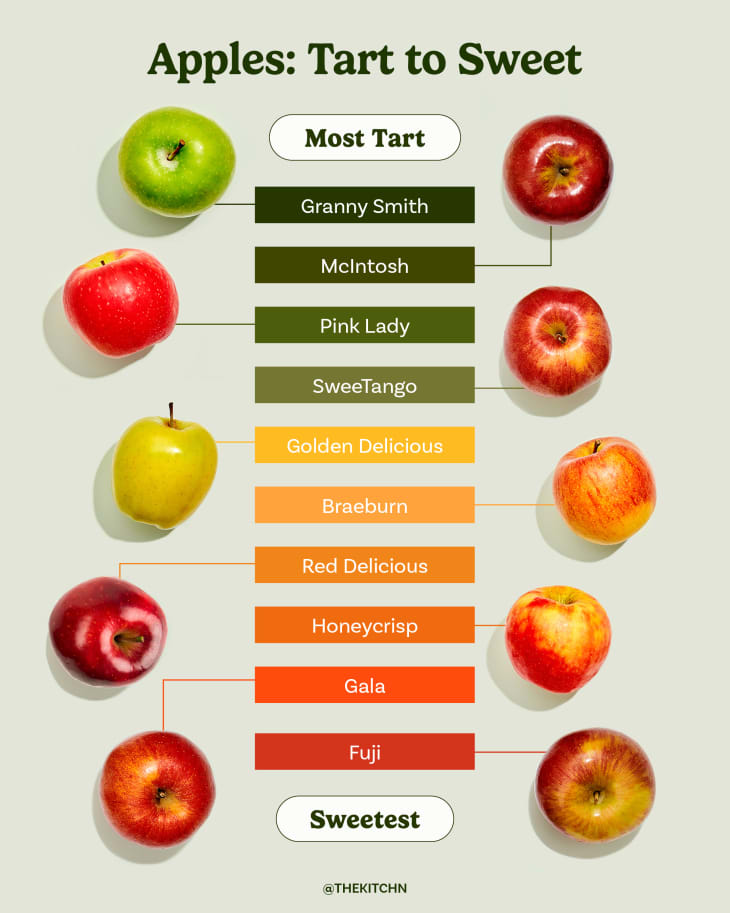The Sweetest Apples, Ranked from Tart to Sweet
Ah, the first signs of fall: There’s a crisp feeling in the air, a strong desire to go back-to-school shopping, and most importantly — it’s the start of apple season. Whether you find yourself at an orchard ready to pick a few freshly grown fruits or are shopping for the perfect variety to make apple pie, consider this your comprehensive guide. Before you start making all of the best apple recipes out there, here’s everything you need to know about the sweetest apple varieties as well as the delightfully tart ones.
What Is the Sweetest Apple?
While there is an extremely wide variety of apples, all with varying flavors, the sweetest-tasting apple is fuji, followed by gala, honeycrisp, and Red Delicious apples. These apples are great for snacking and eating as is.
Granny Smith, McIntosh, and Pink Lady fall on the tart end of the spectrum. While tart apples can be great for snacking, they’re often ideal for baking and can handle a lot of added sweetness. Other types, like Braeburn and Golden Delicious apples, fall somewhere in the middle.
A Guide to Apples From Tart to Sweet
Granny Smith
Granny Smiths are the most tart variety of apple and are indeed named after a real, live granny (in this case, their first propagator Granny Maria Ann Smith). First grown in Australia in the late 1800s, Granny Smith apples are known for their vibrant green color, firm, juicy texture, and strong, tangy flavor. They work well when sliced thin and added to sandwiches or salads but truly shine in baking recipes, where their substantial texture prevents them from becoming overly soft or mushy after cooking.
McIntosh
Far sweeter than the Granny Smith but still tangy, the highly-popular McIntosh are identified by their red-green color pattern, small-to-medium size, and soft, juicy texture. McIntosh apples, which were originally grown in Canada and still serve as the country’s national apple, don’t hold up well to baking but are well-suited for cider, juice, apple sauce or just enjoying fresh from the tree.
Pink Lady
Pink Lady apples are known for their blush color, firm texture, and tart-sweet, juicy flavor. They were first grown in 1973 by Western Australian researcher John Cripps, who discovered the flavor by crossing Golden Delicious and Lady Williams apple varieties. Having landed in the US in the 1990s, Pink Lady Apples are a relatively new apple for American consumers and are popularly enjoyed in snacks and salads as well as in pies.
SweeTango
SweeTangos are the product of crossing Zester and Honeycrisp varieties. They burst onto the scene in 2009 and are known for their red-blush color, mixture of sweet, spicy, and acidic flavors and firm, crunchy texture. SweeTango apples are best enjoyed as snacks but can also be incorporated into baking and cooking recipes.
Golden Delicious
Golden Delicious were originally discovered in West Virginia around the early 1900s and are identified by their bright yellow-green color, thin skin, mellow flavor, and firm texture. Golden Delicious apples hold up well for both raw snacking or baking.
Braeburn
Braeburn apples were first grown in New Zealand in the 1950s and are easily identified by their tie-dye blend of red, yellow, orange, and green colors, nutmeg and cinnamon-adjacent flavor, golden interior, and firm texture. Braeburns can be enjoyed raw in sandwiches, salads and snacking as well as in baked dishes like apple pie.
Red Delicious
Red Delicious apples are an extremely popular US variety but perhaps the most controversial of the bunch. Discovered in 1870s Iowa, they are known for their deep red color, thick skin, and intensely sweet flavor with very little acidity, Red Delicious apples have a soft texture that can very easily turn mealy. For this reason, Red Delicious apples are best enjoyed raw as a snack or in salads.
Honeycrisp
Honeycrisp apples were developed in the 1960s at the University of Minnesota and are engineered to have a juicier bite. They are also known for their bright red-yellow color, tart-sweet flavor, and creamy-yet-crunchy texture. They work well as a raw snack, juiced, or in baked dishes like apple pie.
Gala
Initially grown in New Zealand in the 1930s, Gala apples are a mix between Golden Delicious and Kidd’s Orange Red apples and are one of America’s favorite choices for fall fruit. Gala apples are smaller and more oblong than many other apple varieties and are identified by their orange-red color, sweet flavor, and firm texture. Gala apples are well-suited to snacking and baking and also freeze well.
Fuji
Fuji apples are named after their origin city, Fujisaki, Japan, and were first grown in the 1930s as a hybrid between the Red Delicious and Virginia Ralls Janet varieties. Now one of the US’s most popular varieties, Fuji apples are identified by their red-yellow coloring, firm texture, and deeply sweet flavor that resembles the taste of apple juice. Fuji apples are hearty and store well, making them a good fit for snacking, applesauce, and baking alike.
